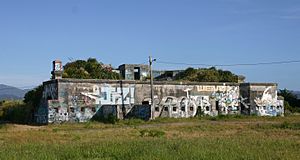Fort Ballance facts for kids
Quick facts for kids Fort Ballance |
|
|---|---|
 |
|
| Location | Point Gordon, Wellington |
| Built | 1885 |
| Designated | 19 July 1990 |
| Reference no. | 5074 |
Fort Ballance is an old coastal fort located on Point Gordon, near Wellington's Miramar Peninsula. It was built in 1885 because people were worried about a possible war with Russia.
This fort is one of the best-kept examples of the many forts built in the 1800s. These forts were made to protect New Zealand from attacks by ships. In 1885, the government realized they couldn't just rely on Britain for protection. So, they asked engineer Major Henry Cautley to design forts for New Zealand's main ports. Fort Ballance was the most important fort in the Wellington area for 26 years, from 1885 to 1911. The military used it for 60 years, until 1945. The fort still looks much like it did in the 1880s. It shows us the old technology used for coastal defense and is an early example of using concrete in buildings.
Contents
Exploring Fort Ballance
Fort Ballance is the biggest military site on the land between Mahanga Bay and Scorching Bay. Other smaller forts nearby, like Fort Gordon, are now mostly buried.
The fort was built to fit the shape of the land. Workers used earth to build up the middle part, where the command post and communication center were. Earth also protected the living areas, bathrooms, ammunition storage, and supply rooms behind the gun areas.
The back of the fort, near the living quarters, had walls with small openings for muskets. Some parts of these walls have been taken down.
Fort Ballance had five main gun positions facing the water. These gun pits were made of concrete and were either round or half-round. Even though the guns are gone, their positions are still there.
Other firing support was located at Kau Point and Point Halswell. The fort was also protected from land attacks by another defense spot on Mount Crawford.
How Fort Ballance Was Built
Fort Ballance was designed to be a complete fort that could defend itself from attacks by land. It was first built using timber, mortar, and corrugated iron sheets. Former police officers and prisoners from Mount Crawford Gaol helped build it. In the 1890s, the wooden parts were rebuilt using strong concrete.
Fort Ballance's Guns
The types of guns at Fort Ballance changed over the years. Here are some of the main ones:
Main Fort Guns
- 1885-1910: Two seven-inch R.M.L. guns.
- 1886-1924: One six-inch disappearing gun.
- 1903-1924: Another six-inch disappearing gun was added. It replaced one of the older seven-inch guns.
- 1892-World War I: Two Q.F. Nordenfeldt six-pounder guns were placed at the corners.
Fort Gordon's Guns
Fort Gordon had these main guns:
- 1895-1924: One eight-inch disappearing gun.
- One QF 3-pounder Hotchkiss gun (at the Spur Battery).
The Seesaw Searchlight
Below and to the east of Fort Ballance was a special "seesaw" searchlight. It was set up in 1891 and powered by a steam engine inside the fort. This searchlight had an electric lamp that could create a very strong beam of light to find targets. The lamp itself was hidden in a deep spot to protect it from enemy fire. A large mirror, attached to a "seesaw" arm, reflected the light beam across the water.
This searchlight could light up targets from the harbor entrance all the way to Ward Island. It was very powerful, like 50,000 candles!
Only a few of these unique searchlights were ever built anywhere in the British Empire. It was hard to use and never worked very well. So, it was stopped being used in 1899, but you can still see where it was located today.

